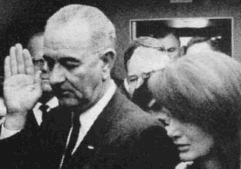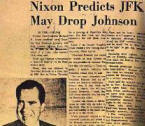 |
||
| In a television interview, A
Current Affair, the mistress of Lyndon Johnson,
Madeleine Brown, described the meeting of 21st November, 1963, when
she was at the home of
Clint Murchison. Others at the meeting included
Harold L. Hunt,
J. Edgar Hoover,
Clyde Tolson,
John J. McCloy and
Richard Nixon. At the end of the evening
Lyndon B. Johnson arrived... "Tension filled the room upon his arrival. The group immediately went behind closed doors. A short time later Lyndon, anxious and red-faced, reappeared... Squeezing my hand so hard, it felt crushed from the pressure, he spoke with a grating whisper, a quiet growl, into my ear, not a love message, but one I'll always remember: "After tomorrow those goddamn Kennedys will never embarrass me again - that's no threat - that's a promise.". It's important to note that John J. McCloy was a member of the now discredited Warren Commission which "investigated" the assassination, appointed by none other than Johnson. Nixon himself was in Dallas on the day of the assassination.
The lead prosecutor in this so called investigation is Sen Arlen Specter. Today, he is Chairman of the Senate Judiciary Committee, insuring that while he is alive, the miscarriage of justice perpetrated on an American president will never be addressed. |
 Newly released JFK documents raise questions about medical evidence
Newly released JFK documents raise questions about medical evidence
By DEB RIECHMANN
Associated Press Writer
WASHINGTON (AP) -- The latest batch of John F. Kennedy assassination documents raises new questions about an examination of the president's brain and lays out unresolved discrepancies in other medical evidence.
The more than 400,000 pages of records being made public at the National Archives today were compiled in the past four years by the Assassination Records Review Board, an independent panel that Congress set up to collect and release material related to Kennedy's death in Dallas on Nov. 22, 1963.
Congress did not direct the review board to reinvestigate the assassination, and the panel issued no formal opinions on any aspect of the controversial murder. But in the board's effort to expand and clarify the record, details surfaced that:
-- Suggest two different brain exams may have been conducted at the Bethesda, Md., Naval Medical Center, raising questions about the authenticity of the brain examined.
-- Fail to resolve discrepancies between how physicians at Parkland Hospital in Dallas described Kennedy's head injury immediately following the shooting and how it was subsequently described by pathologists at Bethesda.
Although the Warren Commission concluded that Kennedy was shot from behind by a single gunman, how Kennedy was assassinated and from what direction he was shot have nonetheless been hotly debated for 35 years. The review board studied old testimony and medical evidence and re-interviewed witnesses, but still was unable to resolve certain issues.
"There are questions about the supplemental brain exam and the photos that were taken. There are inconsistencies in the testimony of the autopsy doctors about when that exam took place," said Jeremy Gunn, executive director and general counsel of the board, which closed out its work in September. "These are serious issues. The records are now out there for the public to evaluate."
Three military pathologists agree they conducted an autopsy of Kennedy's entire body at Bethesda immediately after it was flown back from Dallas. But the doctors offer conflicting recollections about the timing of a subsequent brain exam.
Two doctors, J. Thornton Boswell and James Humes, told the review board that the brain exam occurred two or three days after Kennedy's death. Initially, Humes told the Warren Commission that he, Boswell and a third pathologist, Dr. Pierre Finck, were present when the brain was examined. But when he testified to the review board in 1996, Humes did not list Finck among those present. Boswell maintains Finck was not there.
On the other hand, Finck says the brain exam did not occur until much later. In a memo he wrote to his commanding officer 14 months after Kennedy was assassinated, Finck said Humes did not call him until Nov. 29, 1963 -- seven days after Kennedy's death -- to say it was time to examine the brain. In the memo, Finck said all three pathologists examined the brain together and that "color and black-and-white photographs are taken by the U.S. Navy photographer."
LEFT to Right: James Humes, Thorton Boswell, Pierre Finck.
The conflicting testimony caused Douglas Horne, chief analyst for military records, to conclude in a 32-page memo that two separate brain exams may have been conducted, "contrary to the official record as it has been presented to the American people." "If true, Dr. Finck's account of a brain exam separate and distinct from the first one would mean that Drs. Humes and Boswell were present at two different brain exams," he writes.
 Humes was ill and could not be interviewed. In a telephone interview, Boswell reiterated that the brain was examined at the initial autopsy of the body and only once more at a separate brain exam a few day later.
Humes was ill and could not be interviewed. In a telephone interview, Boswell reiterated that the brain was examined at the initial autopsy of the body and only once more at a separate brain exam a few day later.
"I doubt very much that we would have called him (Finck) back over for that," Boswell said. Boswell added that the only photos of the brain were taken at the autopsy.
This conflicts with testimony the board obtained from Navy photographer John Stringer, who said he took pictures of the brain two or three days after the autopsy. Stringer also testified that official photos of the brain preserved at the archives do not match those he remembers taking. He cites discrepancies in the angles from which they were shot and the type of film used.
In addition, former FBI Agent Francis O'Neill Jr., who watched doctors remove Kennedy's brain the night he died, told the review board that the archives' photos do not resemble what he saw. "I did not recall it (the brain) being that large," O'Neill said.
Throughout the years, doctors who treated Kennedy in Dallas said his head wound was about the size of a large egg at the back of the head, behind his right ear. The Dallas doctors told reporters then that they believed Kennedy was shot from the front -- a belief that conflicted with the Warren Commission's later conclusion of a single shooter firing from behind.
Humes, chief pathologist for the autopsy at Bethesda, agreed there was a wound to the right rear of Kennedy's head, but he told the board that it was a small entry wound, not an egg-sized exit wound. In contrast to observations in Dallas, Humes said there also was massive damage to the top of exit wound. In contrast to observations in Dallas, Humes said there also was massive damage to the top of Kennedy's skull and right side forward of the ear.
Copyright 1998 Associated Press
